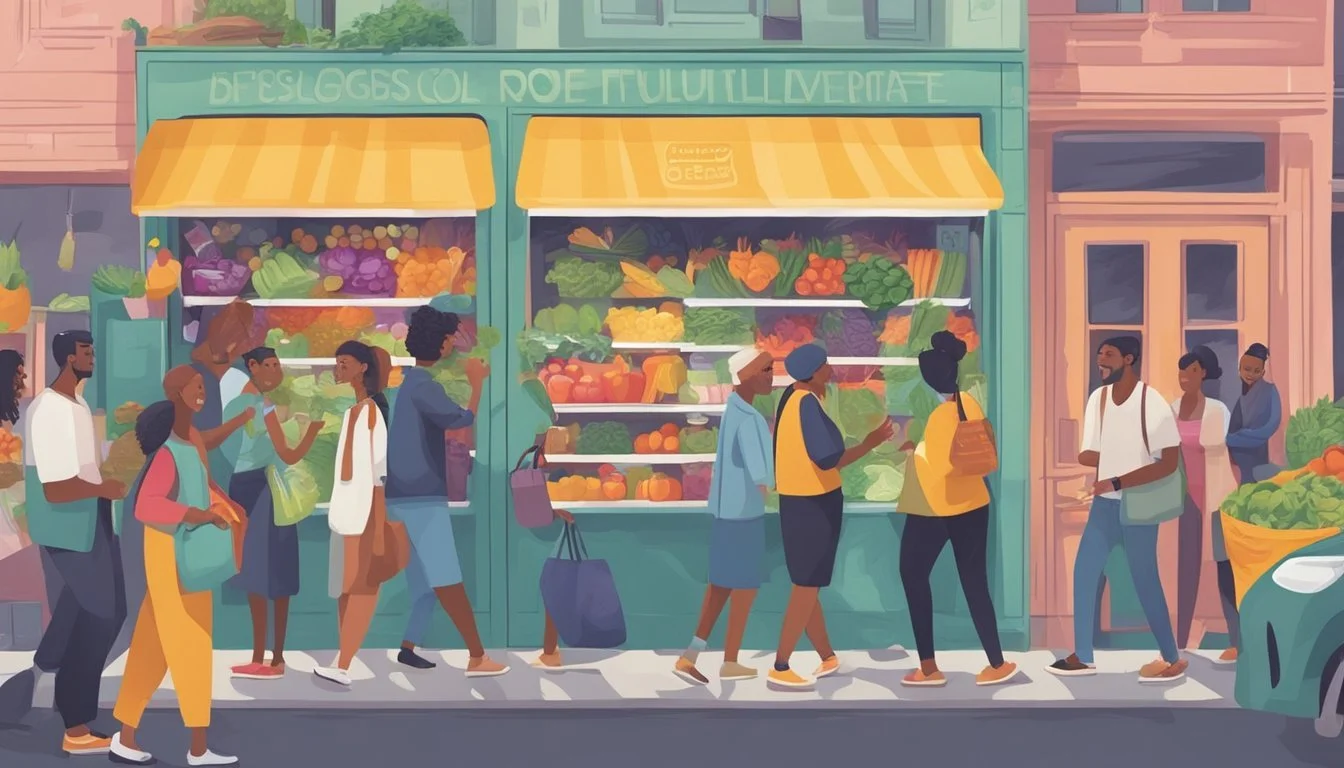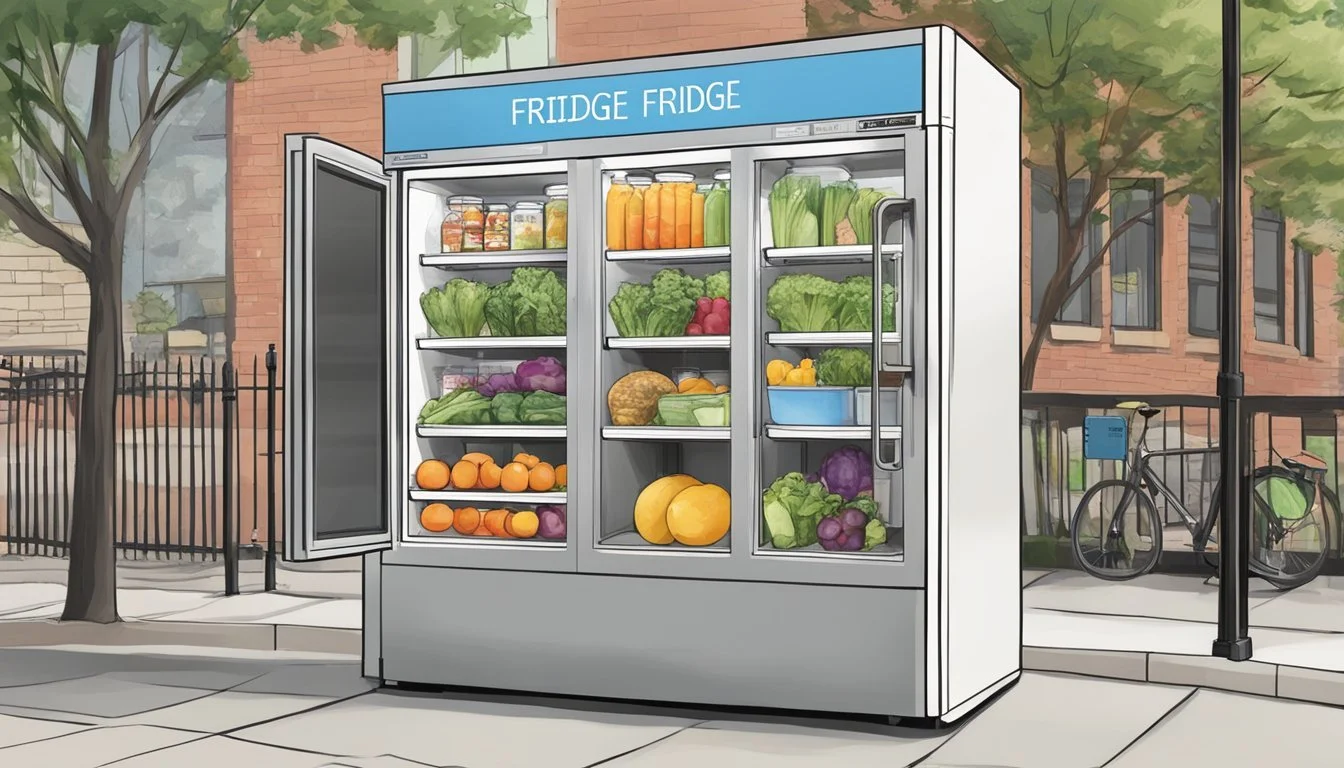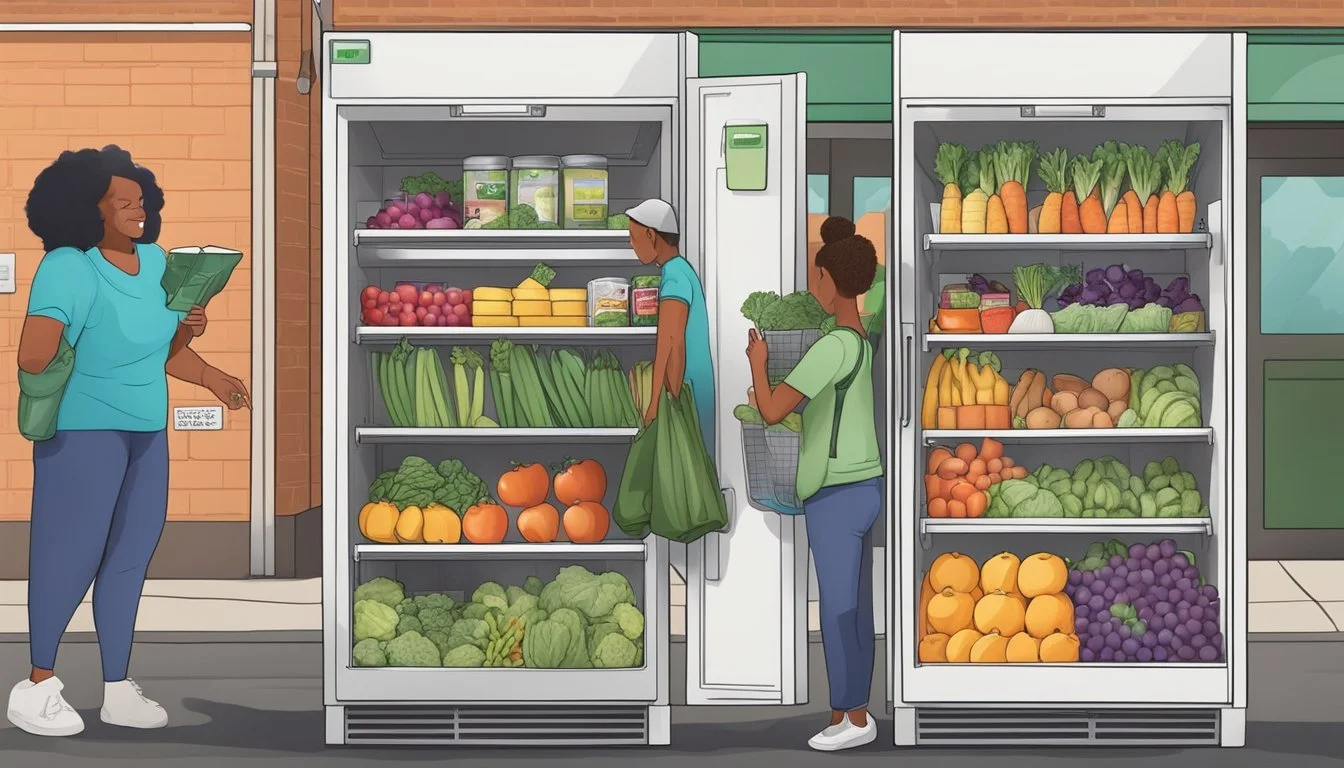Hartford, CT Community Fridge
Addressing Food Insecurity Locally
In Hartford, Connecticut, a city known for its vibrant community and culture, an innovative solution to food insecurity is taking root. The "Community Fridge" initiative, part of a larger, global movement, has been introduced to tackle the issues of hunger and food wastage at a local level. These fridges offer a place where individuals and families in need can access fresh, free produce and other food items, no questions asked. Located throughout the community, these public pantries operate on a simple principle: "Take what you need, leave what you can."
One notable community fridge is located at 280 Vine Street, in a residential area of Hartford. This particular fridge, affectionately known as Fridgeford, stands in the front yard of a red house that blends in with the neighborhood it serves. Operating on a 24/7 basis, Fridgeford and similar fridges across the city provide crucial support to Hartford residents, complementing the efforts of traditional food banks and charity services.
The significance of the community fridge in Hartford transcends merely providing food; it strengthens community ties and empowers residents to support one another in times of need—cultivating a spirit of sharing and mutual aid that is central to the ethos of the initiative. As these fridges become more common, they signify a growing movement towards food security, community resilience, and sustainability.
History and Mission of Community Fridges
Community fridges in Hartford, Connecticut are a testament to the city's resolve to combat food insecurity through mutual aid—a form of community self-help. They offer a real-time solution to food waste and provide a platform for food donations.
Origins of Hartford Community Fridge
The Hartford community fridge, also known as "Fridgeford," is a grassroots initiative that emerged in response to the growing needs amplified by the pandemic. Inspired by global mutual aid efforts, local volunteers established a community fridge to address the immediate challenges of food insecurity. Placed in easily accessible locations, these refrigerators are a beacon of community support allowing anyone to take what they need or leave what they can.
Launch: Beginning with a single fridge
Expansion: Grew with additional installations over time
Access: Available 24/7 to ensure no one goes without food
Goals and Benefits
The goals of community fridges like Hartford's Fridgeford are multifaceted. They not only provide food to those in need but also foster community engagement and reduce food waste through the redistribution of perishable items.
Food Insecurity: Alleviate hunger by removing barriers to food access
Mutual Aid: Strengthen community bonds through shared resources
Food Waste: Minimize waste by repurposing surplus food
Donations: Encourage local residents and businesses to contribute
Benefits include:
Increased food availability
Environmental sustainability through waste reduction
A deeper sense of solidarity and shared responsibility within the community
Location and Accessibility
In Hartford and New Haven, Connecticut, community fridges operate to provide free food to those in need. These fridges are located in accessible locations, available to the local community for both donations and food retrieval.
Hartford and New Haven Fridge Locations
In Hartford, the community fridge known as Fridgeford is situated at 280 Vine Street. It stands in the front yard of a red house within a residential neighborhood, ensuring that those living nearby have easy access to its contents.
In New Haven, a similar initiative titled Fridge Haven is operational, located in the parking lot of Varick Memorial AME Zion Church at 242 Dixwell Avenue. This placement in a public area allows for convenient access by community members.
Fridgeport and Manchester Accessibility
Bridgeport is home to Fridgeport, another community fridge project that follows the principle of “take what you need, leave what you can.” It's set up in a location central to community interaction to maximize its reach and effectiveness.
In Manchester, while specific locations for community fridges might not be directly mentioned in the search results, the emphasis is on ensuring these fridges are placed within easy reach for residents, thereby improving food security in the area. Locations are chosen with visibility and accessibility in mind, so that the support they offer is readily available to those who need it.
Contributions and Support
The success of the Hartford, CT Community Fridge, often referred to as "Fridgeford," rests heavily on the support it receives from local entities and individuals. This support includes food donations and volunteer efforts that are critical to keeping the community fridge running efficiently.
Local Businesses and Restaurants
Restaurants and local businesses play an integral role in maintaining the stock of the community fridge. Many establishments contribute by providing surplus food that is still fit for consumption but cannot be sold. Kingdom Builders Impact Ministries, a noted participant, aids in this initiative, creating a vital link between businesses with excess food and individuals in need. By preventing waste and supporting food security, these businesses demonstrate a commitment to their community.
Individual and Community Donations
Beyond the involvement of businesses, the Hartford community fridge thrives due to the generous contributions from individuals. Donations vary widely and include non-perishables, fresh produce, and ready-to-eat meals. These contributions are facilitated through safe and easily accessible drop-off points. Volunteers, often coordinated via social media platforms like Instagram, manage the fridge's operations, ensuring that food is available 24/7 to those in need.
Donation Examples:
Fresh Produce
Canned Goods
Packaged Meals
Volunteer Activities:
Stocking and organizing fridge contents
Cleaning and maintenance of the space
Outreach via social media, such as Instagram posts to engage the community and update on current needs
The combined efforts of individuals, businesses, and groups like Kingdom Builders Impact Ministries ensure that the "Fridgeford" remains a reliable resource for the Hartford community.
Operational Guidelines
The Hartford, CT Community Fridge operates under specific rules to ensure that it serves the community effectively. Adherence to these guidelines guarantees that the fridge remains a safe, clean, and reliable resource for everyone.
Usage Rules and Maintenance
The community fridge is governed by clear usage rules. Individuals are encouraged to:
Take what you need: Ensuring there's enough food for everyone.
Leave what you can: Supporting the community by contributing food items.
Maintenance responsibilities are shared among community volunteers. They:
Regularly check food expiration dates and remove spoiled items.
Organize and restock food to keep the fridge tidy and accessible.
Safety and Cleanliness Standards
Safety and cleanliness are paramount. The fridge is subject to the following standards:
Regular cleaning: Both the interior and exterior of the fridge are cleaned and sanitized, abiding by health and safety regulations.
Proper food storage: Items are correctly stored to prevent contamination.
All food donations must be sealed or packaged in clean, non-leaking containers and promptly placed in the fridge to maintain freshness. Food coming from a market or other sources must be accompanied by a note or paper specifying the contents and the date it was prepared or purchased. This practice ensures transparency and safety of all items within the community fridge.
Community Impact
In Hartford, CT, Community Fridges serve as a direct response to local food insecurity while supporting broader efforts of food justice and sustainability. These refrigerators are more than simple food storage units; they are a symbol of community resilience and a step towards environmental stewardship.
Addressing Food Insecurity
Community Fridges in Hartford are tackling food insecurity head-on by providing consistent access to free, nutritious food. They operate on a no-questions-asked basis, ensuring that anyone in need can obtain food without hurdles. The refridgerators' placement in accessible locations is strategic, aiming to reach individuals who may not readily benefit from government assistance programs such as the Supplemental Nutrition Assistance Program (SNAP). By reducing barriers, these communal resources aid in addressing poverty and hunger in a dignified manner.
Typical contents include:
Fresh produce
Bread and bakery items
Non-perishable goods
Occasionally, prepared meals
Promoting Food Justice and Sustainability
Hartford's Community Fridges embody the principles of food justice by redistributing resources to mitigate food waste and promote equity within the food system. Through mutual aid groups, volunteers maintain the fridges and cultivate partnerships with local businesses for regular donations, which contributes to a reduction in food waste. These efforts intersect with environmental sustainability, as rescued food that would otherwise end up in landfills is utilized to nourish the community. The fridges provide a platform for education and awareness, fostering a sense of shared responsibility and bringing to light systemic issues within the traditional distribution of resources.
Future Initiatives and Challenges
The Hartford CT Community Fridge aims to extend its outreach and enhance its services, yet it confronts several challenges along the way. These hurdles range from securing consistent donations to navigating logistical complexities.
Expansion Plans
Expansion Plans: The Community Fridge seeks to grow its network in collaboration with local businesses, grocery stores, and educational institutions such as universities and colleges. Their goal is to increase the number of fridges within Hartford, enhancing food accessibility for those affected by the economic aftermath of the Covid-19 pandemic.
Establishment Goals:
Partner with two more grocery stores by the next quarter.
Collaborate with five local universities within the year.
Donation Targets:
Increase food donations by 30% over six months.
Secure monthly commitments from at least three new business donors.
Overcoming Obstacles
Overcoming Obstacles: The initiative faces challenges such as ensuring the sustainability of donations and coordinating effective delivery systems.
Sustainability of Donations:
Donor Retention: Robust strategies are in place to retain current donors while attracting new ones.
Awareness Campaigns: Regular community outreach is planned to keep the issue of food insecurity in the public eye.
Logistical Complexities:
Storage Space: Exploring additional storage solutions to accommodate a larger volume of perishable items.
Distribution Method: Implementing a more structured delivery process to streamline distribution, especially during peak times.
How to Get Involved
Engaging with the Hartford, CT Community Fridge initiative offers various pathways for community members to contribute toward alleviating food insecurity. One can partake by offering time as a volunteer or by making financial contributions to support the cause.
Volunteering Opportunities
Volunteers are the backbone of the community fridge initiative. They can assist by:
Monitoring and stocking the fridge with food items.
Ensuring the cleanliness and organization of the space.
Spreading the word about the fridge and its mission within the community.
How to volunteer:
Reach out to the organizers through the Fridgeford Instagram account.
Visit the fridge location at 280 Vine Street, Hartford CT to see if volunteers are needed onsite.
Financial Contributions
Financial donations are critical for covering operational expenses such as electricity and maintenance. There are multiple platforms where monetary support can be provided:
Ways to donate:
Platform Details Venmo Direct funds to the Hartford Community Fridge’s Venmo account. Find the details on their social media pages. Cashapp Contribute via Cashapp using the handle provided by organizers. GoFundMe Look for the official fundraising campaigns for the Hartford Community Fridge.
Donations of any size are appreciated and help sustain the community fridge's mission to provide free food access to residents in need.
Media and Testimonials
The Hartford, CT Community Fridge has garnered attention for its positive impact on food insecurity and the compelling stories that underscore its success. Public figures like Aida Rivera and Reggy Saint Fortcolin have become associated with these community efforts, and their actions have amplified the project's visibility.
Success Stories
The Hartford community fridge, often affectionately referred to as "Fridgeford," has several success stories that underscore its positive impact. One notable community organizer, Reggy Saint Fortcolin, has played a key role in not only the Hartford area but in establishing similar projects across Connecticut, showing the replicability and success of the community fridge concept. Individuals like Aida Rivera have connected with the project, tapping into their networks to expand the reach and effectiveness of community fridges.
Coverage in News and Social Media
The Hartford Community Fridge has attracted coverage from local news outlets, celebrating its contribution to the community. On social media, platforms like Instagram have become pivotal in sharing real-time updates and stories, drawing both attention and resources to the initiative. Utilizing social media, public figures and organizers have increased public awareness and publicity, leading to a more robust local response to meet the community's needs.
Through a strategic use of media channels and the sharing of testimonials from those who have been helped, the Hartford Community Fridge exemplifies how community-driven solutions can make a significant impact on complex social issues.
Contact Information
In Hartford, Connecticut, the community fridge initiative—referred to as Fridgeford—is located at 280 Vine Street. It stands prominently in the front yard of a red house. This fridge facilitates access to food for those who are food insecure by allowing anyone to take what they need or leave food donations at any time.
Instagram: For updates and coordination, Fridgeford maintains an active presence on Instagram. Interested individuals or parties looking to connect or contribute to this community endeavor should follow their account:
@Fridgeford: The official page for news, needs, and updates.
Food Donations: Fridgeford welcomes food donations at the community fridge location. Those who wish to support must ensure that the food is fresh and safe to consume. No reservations or prior contact is necessary to donate food.
Volunteering: Fridgeford also relies on volunteers for maintenance and stocking. Interested parties can inquire through Instagram to get involved.
General Inquiries: For parties requiring additional information or interested in starting a similar initiative, direct messaging through Instagram is the preferred method of communication. Inquiries will be met with a knowledgeable and helpful response.
Appendix
This section provides supplementary information relevant to the Hartford, CT Community Fridge initiative. It directs readers to additional resources for in-depth understanding and outlines related local efforts that align with this community-driven food assistance program.
Further Reading
USDA Resources: For comprehensive insights on food security, the USDA offers various reports and guidelines, accessible at USDA's Official Website.
Freedge Movement: To explore the broader concept behind community fridges, the Freedge website serves as a knowledge hub with a map of locations worldwide, available at Freedge.
Related Local Initiatives
COVID-19 Response Efforts: Community fridges emerged as a direct response to increased food insecurity due to the Coronavirus pandemic. More information on local initiatives can be found on the Center for Disease Control and Prevention website.
Local Food Pantries: Information about other local food assistance programs in Hartford can be accessed by contacting food banks and pantries in the area.
Acknowledgments
The success of the Hartford, CT Community Fridge initiative can be largely attributed to a collective effort. Volunteers have been pivotal in the stewardship of community fridges throughout Connecticut, particularly in Hartford. Their dedication to maintaining and stocking the fridge, located at 280 Vine Street, exemplifies a strong sense of solidarity within the community.
Several members of the local community have also shown remarkable charity, contributing food items and essential supplies. These individuals often act anonymously with no expectation of recognition, simply aiming to support those in need. Their contributions ensure the fridge is continuously supplied, making free food available 24/7.
Contributor Role Local Residents Donations, Maintenance Local Businesses Provision of Supplies Community Organizers Coordination, Oversight
Local businesses deserve acknowledgement for their support, either through donations or by offering resources that aid the initiative's operational aspects. Their involvement solidifies the bridge between commercial entities and community welfare, reinforcing the symbiotic relationship that benefits Hartford's wider community.
Community organizers have been fundamental in conceptualizing and installing the Hartford fridge. They took inspiration from similar initiatives that have thrived in New Haven, Waterbury, and beyond, adapting the concept to meet local needs. Their continuous engagement ensures that the fridge remains a reliable resource for residents facing food insecurity.
References
Community initiatives, such as the Fridgeford in Hartford, CT, are grassroots efforts aimed at addressing food insecurity by providing free access to food. The following references offer insight into the function and impact of community fridges in Hartford and similar projects:
Academic References: Research on food sharing economies, particularly in urban settings, has been addressed in various scholarly articles. These studies examine the socio-economic impact of communal resources like community fridges.
Government Reports: The City of Hartford may have publicly accessible data on local food assistance programs, including community fridges. Government census data can also provide context on the levels of food insecurity in the area.
Market Statistics: Nonprofit organizations and food security networks often release statistics on the usage and distribution of resources through initiatives like community fridges. These statistics can provide measurable insights into their effectiveness.
To further understand the practical application and administration of these fridges, one might consider reviewing specific details about the Fridgeford initiative at 280 Vine Street, Hartford CT. Key points include:
The fridge being open 24/7
Its location in a residential neighborhood
The policy of "take what you want, leave what you can"
For a more personal perspective on these efforts, interviews and quotes from community organizers such as Reggy St. Fortcolin, who has been instrumental in starting up community fridges across Connecticut, add a layer of depth to the available data.
Local media channels and community blogs often feature updates and stories about the Fridgeford and similar projects, showcasing their evolving role within the city.
About the Author
The author, with a background in journalism and community development, has spent several years covering social initiatives and local activism. Their professional experience includes in-depth reporting on urban community projects and grassroots movements. Foremost in their portfolio is a series of articles highlighting the roles of community fridges in urban food security.
Education and Credentials:
The author holds a Bachelor's Degree in Journalism and a Master's in Urban Studies. They have attended numerous workshops on social justice and sustainable urban development.
Published Works:
"Urban Hunger and Community Solutions"
"Grassroots Movements: The Pulse of Urban Innovation"
Relevant Experience:
Two years as a beat reporter for urban development issues.
Volunteer experience with food security nonprofits.
In their reportage on Hartford's Community Fridge, the author brings a balance of investigative dedication and ethical storytelling. They approach each article with a commitment to unearthing facts and providing truthful, objective content. Their writing is informed by both a thorough understanding of community-based efforts and the larger systemic challenges that such initiatives seek to address.
Disclaimer
The information provided about the Hartford, CT Community Fridge is presented with the intent to inform and benefit the public. There are legal and content accuracy aspects users and providers should be aware of:
Legal Disclaimers
Legal Compliance: The providers of the Hartford Community Fridge cannot ensure that all food items are in compliance with local health and safety regulations. Users consume at their own risk.
No Liability: The Hartford Community Fridge and its affiliates, volunteers, or representatives will not be held liable for any health issues that may arise from the consumption of food items provided.
Content Accuracy
Current Information: The article endeavors to present the most current information regarding the location and operation of the Hartford Community Fridge. However, the details such as fridge locations and hours of operation are subject to change without notice.
No Endorsement: Mention of any products, companies, or services does not constitute an endorsement or recommendation by the Hartford Community Fridge.
Use Guidelines
Food Safety: While not responsible for food safety, the Hartford Community Fridge advises users to exercise judgment when selecting food items.
Donation Guidelines: Donors are encouraged to ensure that food items are unopened and not past their expiration date to maintain a standard of quality and safety.
People engaging with the Hartford Community Fridge should remember to respect the service and use it responsibly. The primary goal of the community fridge is to support and uplift by providing food accessibility to all those who may be in need.















